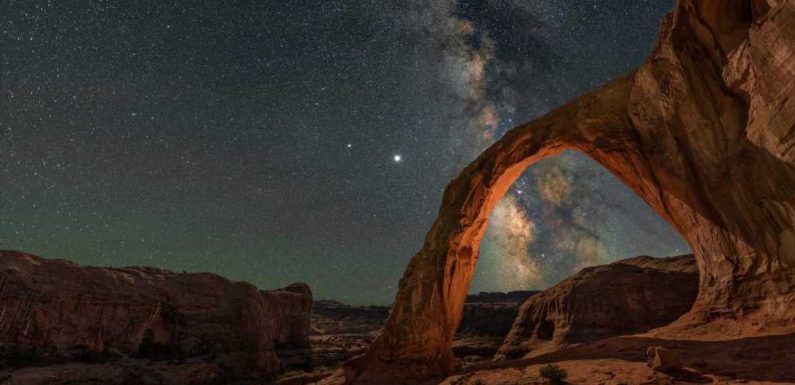
The Milky Way has inspired humans for centuries. But with light pollution making it more difficult to figure out where to go stargazing, more states are taking action to protect the future of their night skies.
Last month, Nevada’s Senate passed a bill recognizing the state’s “dark sky places,” where views of the galaxies draw thousands of visitors per year. If made law, Bill 52 will create a program to help locations navigate the process of earning a new state-level “dark sky” designation and in turn, support environmental conservation and the local economy.
The proposed program follows the footsteps of the International Dark-Sky Association (IDA), an Arizona-based organization that works to designate and protect dark skies around the world. The IDA’s mission is a considerable feat, considering light pollution is now increasing by over 2 percent each year—double the rate of population growth—but experts say the pandemic could be making the rest of us more invested in protecting our view of the stars, too.
“In some places, it’s just dawning on people that if they go outside and look at the night sky, the stars are missing,” says John Barentine, director of public policy at IDA. “They’re discovering the phenomenon of light pollution, maybe for the first time.”
According to satellite data, 80 percent of North Americans can no longer see the Milky Way from where they live, which makes traveling to an internationally recognized dark sky place even more appealing. There are already two in Nevada: Great Basin National Park and the Massacre Rim Wilderness Study Area—both of which saw a spike in visitors after earning their IDA certifications. Meanwhile, seats on Nevada Northern Railway’s Star Train, which follows a nighttime route through Great Basin before stopping to allow passengers to view the planets through telescopes, are regularly sold out. The proposed legislation aims to expand on these options for travelers in Nevada.
Leveraging stars to support sustainable travel
Other states are considering how multi-location dark sky zones could distribute tourism traffic more evenly and encourage travelers to stay longer. In Utah, there is a growing push to create the largest International Dark Sky Reserve recognized by the IDA. If all goes to plan, the Southeastern Utah Night Sky Reserve will span over 20,200 square miles, bridging the skies between nine national parks and monuments, 16 towns and cities, eight state parks, and a large portion of the Navajo Nation.
The focus makes sense. Night-sky tourism, which typically necessitates one or more overnight stays, can increase travel spending. Dark sky advocates are just hopeful that new hospitality developments don’t further contribute to light pollution, says Barentine.
Utah hotels like Amangiri, which caters to astronomy lovers with its open-ceiling sky terraces and private stargazing sessions, could be a template for dark sky lodging done right. The remote luxury property has made an effort to keep outdoor lighting to a minimum—even arming guests with flashlights upon check-in.
In Colorado last year, the state’s tourism board launched Colorado Stargazing: Experience the Night, a self-guided tour that connects seven locations famous for their night skies. One is the IDA-recognized dark sky community of Westcliffe where, as of 2021, you can rent out the Smokey Jack Observatory for a private star party or go on a nighttime Amish wagon ride in Wet Mountain Valley while marveling at constellations.
Battling blue light
While being a certified dark sky place can attract more travelers, meeting the rigorous criteria necessary to achieve IDA designation isn’t easy. In order to qualify with the IDA, lighting best practices must be adopted, which range from placing street lamps on timers to using warm-colored bulbs.
Blue LED light is particularly disruptive to dark skies, wildlife, and humans, and has been linked to everything from sleep disorders to diabetes, according to a report by the American Medical Association. And yet, the world is consuming more LED light than ever due to its energy efficiency.
“If it’s done well, LED lighting could save the world. But when it’s not, it can make light pollution much worse,” says Barentine, who points to Flagstaff, Arizona, as an example of a city that successfully reduced its street lighting emissions by 20 percent after converting to dimmable LED lights. Now, dark sky advocates are focusing on the proliferation of digital billboards, which—while cheap—emit light sideways and often aren’t regulated according to brightness.
A new non-partisan bill being put forward in Massachusetts hopes to address how the state oversees outdoor lighting, and specifically blue light, in public spaces. The proposed changes, which include using fully shielded lighting fixtures for roadways and parking lots, could help reduce skyglow across the state.
“To our knowledge, we would be the first state to limit harmful too-blue lighting,” says Tim Brothers, a site manager at the MIT Wallace Astrophysical Observatory who supports the bill. “It’s not hard to imagine that if we start setting the example at the state-level, others will follow and we could actually restore some of our natural nighttime ambience.”
Brothers says this legislation could create new astrotourism opportunities in destinations like the Berkshires and Cape Cod National Seashore, and restore a view of the Milky Way strewn across an inky black sky.
As states begin to roll out their own policies and the IDA continues its work, there is new enthusiasm for the shared protection of dark skies—and the stargazing opportunities it could create. Natural wonders have always drawn travelers but with the prospect of new road trip routes, moonlit train rides, and midnight hikes, we now have a few more reasons to get outside.
Source: Read Full Article









